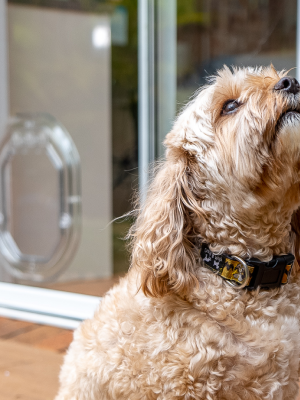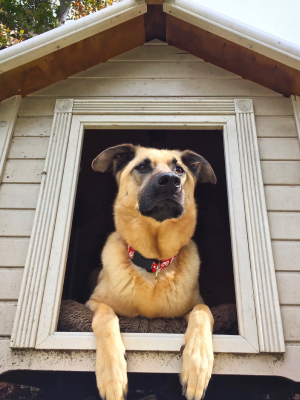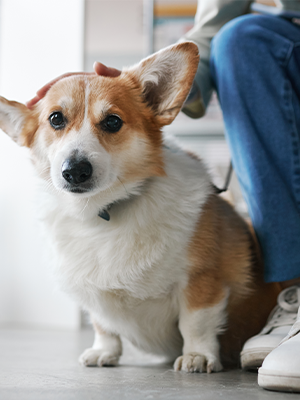
It’s easy to get caught up in the very human world of words and commands – in fact, most dogs do a great job of understanding the words you use. But did you know that dogs themselves mainly communicate through scent and body language?
Our Blog
Our Blog
22/9/23
Dog Body Language: What Is Your Dog Trying to Tell You?
It’s easy to get caught up in the very human world of words and commands – in fact, most dogs do a great job of understanding the words you use. But did you know that dogs themselves mainly communicate through scent and body language? Your dog has gone through all the effort of learning sit, stay, down and all of the commands – it’s about time you understood what your dog was trying to tell you. Luckily, this article will get you there! While understanding your dog might feel intuitive and obvious – as humans we do a great job of projecting our ‘humanness’ onto our pets. In many cases, a dog’s behaviour may mean something completely different to the same behaviour in people. Take yawns, for example, for us it’s a pretty clear link to tiredness or hunger in a person, but in a dog yawns can be a clear sign of anxiety.
By the end of the article, you’ll have an understanding of how to read dog body language and the different emotional states of your dog. Not only that, but you will be on track to make communication with your dog a two-way-street, and ultimately build a stronger bond with your furry friend.
Reading Dog Body Language
There are multiple different ways a dog can be telling you something – both verbally and non-verbally. With non-verbal body language communication there is a lot of nuance across all over the dog’s body and no one signal should be taken in isolation. When considering what your dog is trying to tell you, it’s key to observe them from head to tail. Key areas to look out for are tail position, eyes, ears, lips, ‘hackles’ & overall posture.

Tail Position – Typically a neutral position is a signal the dog is relaxed, but the definition of a neutral position is entirely dependent on the breed – try to figure out what neutral position is for your own breed, as this will help you define normal or ‘relaxed’ for your dog. A pointed, high tail is the signal of strong emotion – although what that emotion means will depend on the rest of the dog’s body language. It could simply mean the dog is confident, alert and aroused or could be a giveaway for something more serious such as aggression or tension – in this instance it is important to consider the other body language of your dog, and the situation they are in.
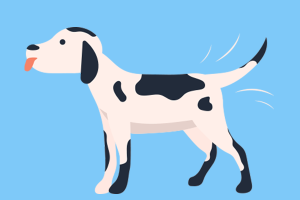
Tail Wag – A wagging tail doesn’t necessarily mean a dog is happy – wagging can actually be highly complex and subtle. Even something as specific as the direction of a dog’s tail wagging can indicate their mood and intentions – studies have shown that a wag to the left is associated with uncertainty or fear, whereas a wag to the right is linked with relaxation. One of the happiest signs in a dog is the ‘helicopter’ or circle wag – essentially when the tail is rotating at the base and cutting a wide circle in the air. This distinctive wag shows up most often when a dog is reunited with family members and typically represents happiness, positivity and friendliness. While direction can play a part in a dog’s emotion, so too can the speed of the wag – a less upright wagging tail is a symbol of a calmer dog – but a wagging tail that slows to a stop can be a warning sign, particularly if it stiffens up. While these signs can be quite subtle, the tail in combination with the rest of the body will give you a good indication of the dog’s behaviour.

Eyes – generally speaking, soft eyes and a sign of a relaxed, calm and happy dog. Whereas an intense, hard stare stare can precede aggression. Finally, constant looking away may be a sign of stress in dogs. Just like humans, a dog’s eyes are extremely expressive.

Posture – this can hold many clues about their mood – from cowering and hunched dogs that display clear signs of stress, to an upright forward leaning posture which can indicate defensiveness. A relaxed dog will have a neutral, upright posture and an unsure dog will seem more floppy and timid.

Ears – ear position is also a good indicator of a dog’s mood – forward ears means the dog is paying careful attention, while pinned back ears may represent fear or aggression. Ears that are back, but not pinned also mean that a dog is relaxed and friendly.
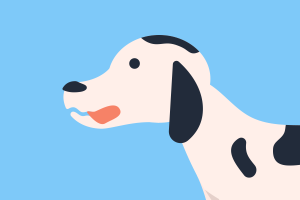
Lips – Lip licking is also a relatively well researched area of dog communication – generally, lip licking is referred to as an ‘appeasement gesture’ and is usually done when dogs want to send a message that they are worried – to sooth the person or animal in front of them and let them know the dog is not a threat. This can appear during training, when a dog may be overly frustrated or misunderstanding the trainer. However, this is another context dependent one – lip licking simply be a sign of appetite or hunger, if accompanied by drooling and before a meal. Similarly, if lip licking is happening frequently, it may represent dental or mouth issues. Finally, curled lips often show up during a fun activity, alongside a wrinkled nose and a sneeze. This is a sign your dog is having fun!

‘Smiling’ – Smiling in dogs is most often a sign of ‘active submission’ another form of appeasement that may be accompanied by lying down on their side or curling over. This may happen naturally, or even while they are feeling guilty about something and want to compensate for their mistake. Smiles may happen with teeth showing too, however it is important to know the difference between a smile and an aggressive dog baring its teeth. Smiling dogs will show other signs of friendliness, such as a helicopter wag or soft eyes – whereas an aggressive dog baring its teeth will look tense and may be moving slowly.
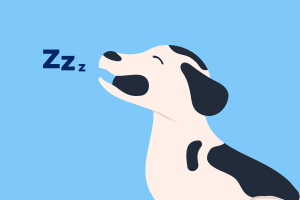
Yawning – Yawning in dogs isn’t a 1:1 match with humans – they may yawn when they are tired or bored but they may also yawn when they are feeling stressed. A ‘stressed’ yawn is typically longer and more intense than a sleepy one.
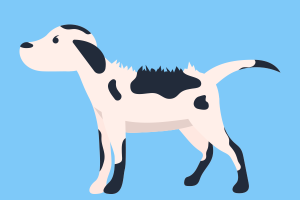
Hackles – Your dog’s hackles are the hairs that line their backbone. Often, the hackles ‘standing up’ is a sign of a strong emotion in dogs – defining what this means is again, extremely context dependent. It could represent aggression, anxiety, excitedness or that your dog is in ‘predator’ mode. Generally, aggression and excitedness will display with other obvious signs, however anxiety may be more difficult to diagnose as there may be no other obvious signs. In this case, monitor your dog closely and if they begin to show other signs of tension or fear, help them to leave the situation.
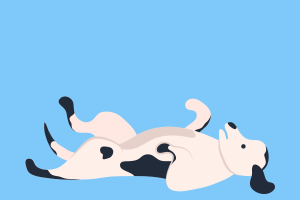
Laying on back – when your pup turns over and invites a belly rub, it can be a sign that he is calm, relaxed and happy. On the flip side, if your dog turns over and is looking tense, this could also indicate anxiety.

Pacing – Pacing in dogs typically means they are finding it tough to settle down, and have something stressing them. This might happen during feeding or only for a brief moment – in these cases it isn’t much to be concerned about – but just noticing when it happens might help you to understand the scenarios and situations that cause stress for your dog.
Tail Position

Typically a neutral position is a signal the dog is relaxed, but the definition of a neutral position is entirely dependent on the breed – try to figure out what neutral position is for your own breed, as this will help you define normal or ‘relaxed’ for your dog. A pointed, high tail is the signal of strong emotion – although what that emotion means will depend on the rest of the dog’s body language. It could simply mean the dog is confident, alert and aroused or could be a giveaway for something more serious such as aggression or tension – in this instance it is important to consider the other body language of your dog, and the situation they are in.
Tail Wag

A wagging tail doesn’t necessarily mean a dog is happy – wagging can actually be highly complex and subtle. Even something as specific as the direction of a dog’s tail wagging can indicate their mood and intentions – studies have shown that a wag to the left is associated with uncertainty or fear, whereas a wag to the right is linked with relaxation. One of the happiest signs in a dog is the ‘helicopter’ or circle wag – essentially when the tail is rotating at the base and cutting a wide circle in the air. This distinctive wag shows up most often when a dog is reunited with family members and typically represents happiness, positivity and friendliness. While direction can play a part in a dog’s emotion, so too can the speed of the wag – a less upright wagging tail is a symbol of a calmer dog – but a wagging tail that slows to a stop can be a warning sign, particularly if it stiffens up. While these signs can be quite subtle, the tail in combination with the rest of the body will give you a good indication of the dog’s behaviour.
Eyes

Generally speaking, soft eyes and a sign of a relaxed, calm and happy dog. Whereas an intense, hard stare stare can precede aggression. Finally, constant looking away may be a sign of stress in dogs. Just like humans, a dog’s eyes are extremely expressive.
Posture

This can hold many clues about their mood – from cowering and hunched dogs that display clear signs of stress, to an upright forward leaning posture which can indicate defensiveness. A relaxed dog will have a neutral, upright posture and an unsure dog will seem more floppy and timid.
Ears

Ear position is also a good indicator of a dog’s mood – forward ears means the dog is paying careful attention, while pinned back ears may represent fear or aggression. Ears that are back, but not pinned also mean that a dog is relaxed and friendly.
Lips

Lip licking is also a relatively well researched area of dog communication – generally, lip licking is referred to as an ‘appeasement gesture’ and is usually done when dogs want to send a message that they are worried – to sooth the person or animal in front of them and let them know the dog is not a threat. This can appear during training, when a dog may be overly frustrated or misunderstanding the trainer. However, this is another context dependent one – lip licking simply be a sign of appetite or hunger, if accompanied by drooling and before a meal. Similarly, if lip licking is happening frequently, it may represent dental or mouth issues. Finally, curled lips often show up during a fun activity, alongside a wrinkled nose and a sneeze. This is a sign your dog is having fun!
‘Smiling’

Smiling in dogs is most often a sign of ‘active submission’ another form of appeasement that may be accompanied by lying down on their side or curling over. This may happen naturally, or even while they are feeling guilty about something and want to compensate for their mistake. Smiles may happen with teeth showing too, however it is important to know the difference between a smile and an aggressive dog baring its teeth. Smiling dogs will show other signs of friendliness, such as a helicopter wag or soft eyes – whereas an aggressive dog baring its teeth will look tense and may be moving slowly.
Yawning

Yawning in dogs isn’t a 1:1 match with humans – they may yawn when they are tired or bored but they may also yawn when they are feeling stressed. A ‘stressed’ yawn is typically longer and more intense than a sleepy one.
Hackles

Your dog’s hackles are the hairs that line their backbone. Often, the hackles ‘standing up’ is a sign of a strong emotion in dogs – defining what this means is again, extremely context dependent. It could represent aggression, anxiety, excitedness or that your dog is in ‘predator’ mode. Generally, aggression and excitedness will display with other obvious signs, however anxiety may be more difficult to diagnose as there may be no other obvious signs. In this case, monitor your dog closely and if they begin to show other signs of tension or fear, help them to leave the situation.
Laying on back

When your pup turns over and invites a belly rub, it can be a sign that he is calm, relaxed and happy. On the flip side, if your dog turns over and is looking tense, this could also indicate anxiety.
Pacing

Pacing in dogs typically means they are finding it tough to settle down, and have something stressing them. This might happen during feeding or only for a brief moment – in these cases it isn’t much to be concerned about – but just noticing when it happens might help you to understand the scenarios and situations that cause stress for your dog.
Of course, much of body language is context dependent and a single body part should not be taken in isolation – a happy dog with a wide grin, open mouth and constant panting might look extremely similar to a warm dog. Typically, on a long walk on a balmy summer day – the dog will be both! Or, during play with other dogs – showing teeth and even some vocalisations are completely normal play behaviour, although in another context showing teeth could be a clear sign of aggression. Often, multiple signals combine to give an overall picture; a playing dog showing their teeth will have a floppy body whereas an aggressive dog showing their teeth may also have their ears pinned back, and a hard stare. With a keen understanding of dog body language, you will be able to read if your dog is feeling calm or anxious, happy, or angry/aggressive.
Reading Calm Dog Behaviour
A relaxed and calm dog is the desired state for many dog owners. Dogs with a wagging tail, loose body and soft eyes are a welcome sight in most homes! Soft eyes, a direct gaze, relaxed ears and a relaxed, open mouth are all classic signals of a relaxed dog.
It’s often said that a tired dog is a happy dog and generally that is true (as long as they’re not too tired!). In order to promote calm behaviour, it’s important to positively reinforce your dog when they perform actions you want repeated. This can encourage them to feel safe and secure, and ultimately more relaxed. Another extremely important element to encourage calmness in dogs is setting them up with a consistent routine and giving them plenty of exercise. A great way to encourage this is to give dogs easy access to the outside, via one of our Dog Doors – this will ensure your dog can get plenty of exercise and enrichment in the garden, as well as the extra mental stimulation they can get from being outside.
Identifying Anxious Dog Body Language
Anxiety in dogs can be more difficult to notice. Some anxiety comes out in a ‘big’ way with destructive behaviours and habits, like excessive digging, destroying furniture and constant pacing. Other forms are much more subtle and may be more difficult to notice – including lip licking, lifting a paw as if ‘unsure’ and showing the whites of the eyes. As well as these subtle clues, some more obvious ones include looking away, yawning, a tucked tail and pulling back their lips.
Fortunately, there are some simple and effective things you can do to help your dog manage their anxiety. The treatment itself can depend on the type of anxiety – for separation anxiety is important to be able to give your dog enrichment and activities to keep their brain occupied while you are away. Generally speaking though, for many breeds anxiety is a result of excess energy. In this case, ensuring your dog’s activity needs are met can make the world of difference – play with other dogs is a great way to manage your own dog’s energy, as well as giving them easy access to the outside with pet doors to help keep them stimulated and ultimately burn off excess energy.
Catching Aggressive Dog Body Language
An aggressive dog will typically have a hard, intense stare, the tail will be carried high and the posture will likely be forward and quite stiff. An aggressive dog will also likely be making vocalisations and become tense when approached.
There are actually many forms and causes of aggressive dog behaviour, although the most common is fear or anxiety based aggression. This can be confusing as the dog may display offensive or defensive forms of aggression (essentially ‘stay away’ vs actively approaching a perceived threat), but most forms of aggression will share a common thread of growling, snarling, barking and hard stares. Fear based aggression may be hard to completely eradicate, but steps can be made to reduce exposure to situations that bring on fear and anxiety in your dog.
While fear is a common driver of aggression, another big one is territorial based aggression. This form of aggressive behaviour arises when a dog feels that an unknown person or animal is approaching their owner’s home or property. In this case, pet doors can help to alleviate territorial behaviour as they give dogs access to the outdoors – where they can generally hear more of the outside world and grow accustomed to all of the different sights, sounds and smells around the property.
Is My Dog Happy?
Every dog owner has probably wondered this at least once. There are some obvious outward signs that your dog is happy, such as a tail carried lower than their back or gently wagging, soft eyes, as well as a tongue lolling out of the mouth and a relaxed body posture. The pinnacle of dog body language happiness – A play bow – is the ultimate sign of happiness and should be cherished!
While raising a happy dog is certainly a lot of effort, the basic concept is pretty straightforward. Socialisation, consistent training, routine and exercise all go a long way to ensuring your dog will have a happy life – the amounts of each area are quite breed dependent, but each dog will thrive with some mix of those tenets. Just as important as breed, is the age of your dog. Patience and care is key with younger, immature dogs who are learning about the world, pushing boundaries and may not understand that they’ve done something ‘wrong’.
Ultimately, your dog does a great job of understanding you (sit, stay, down etc.) and with just a fraction of the effort you can also understand your dog. By taking note of your dog’s body language, you can make communication a two-way street and in turn, support your dog’s needs much more effectively. We hope that this article can be the first step on your journey of building a two-way relationship with your dog.
Latest Posts
Latest Posts
Questions? We’re here to help.

